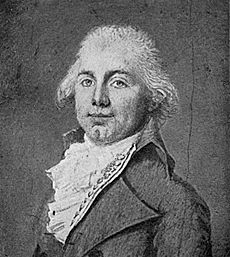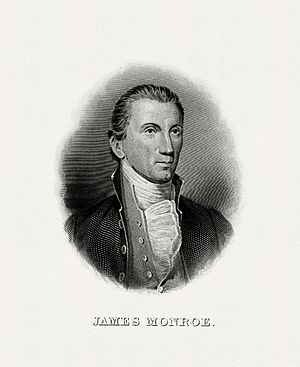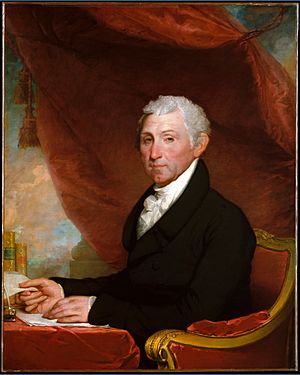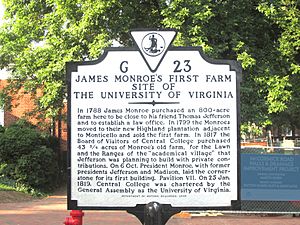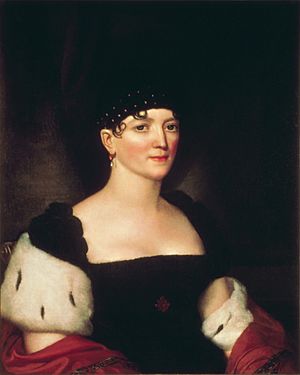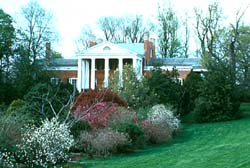James Monroe facts for kids
Quick facts for kids
James Monroe
|
|
|---|---|

Portrait by Samuel Morse, c. 1819
|
|
| 5th President of the United States | |
| In office March 4, 1817 – March 4, 1825 |
|
| Vice President | Daniel D. Tompkins |
| Preceded by | James Madison |
| Succeeded by | John Quincy Adams |
| 7th United States Secretary of State | |
| In office April 6, 1811 – March 4, 1817 |
|
| President | James Madison |
| Preceded by | Robert Smith |
| Succeeded by | John Quincy Adams |
| 8th United States Secretary of War | |
| In office September 27, 1814 – March 2, 1815 |
|
| President | James Madison |
| Preceded by | John Armstrong Jr. |
| Succeeded by | William H. Crawford |
| 12th and 16th Governor of Virginia | |
| In office January 16, 1811 – April 2, 1811 |
|
| Preceded by | John Tyler Sr. |
| Succeeded by | George W. Smith |
| In office December 28, 1799 – December 1, 1802 |
|
| Preceded by | James Wood |
| Succeeded by | John Page |
| 4th United States Minister to the United Kingdom | |
| In office August 17, 1803 – October 7, 1807 |
|
| President | Thomas Jefferson |
| Preceded by | Rufus King |
| Succeeded by | William Pinkney |
| 5th United States Minister to France | |
| In office August 15, 1794 – December 9, 1796 |
|
| President | George Washington |
| Preceded by | Gouverneur Morris |
| Succeeded by | Charles Cotesworth Pinckney |
| United States Senator from Virginia |
|
| In office November 9, 1790 – May 27, 1794 |
|
| Preceded by | John Walker |
| Succeeded by | Stevens Thomson Mason |
| Delegate from Virginia to the Congress of the Confederation | |
| In office November 3, 1783 – November 7, 1786 |
|
| Preceded by | Constituency established |
| Succeeded by | Henry Lee III |
| Personal details | |
| Born | April 28, 1758 Monroe Hall, Virginia, British America |
| Died | July 4, 1831 (aged 73) New York City, U.S. |
| Resting place | Hollywood Cemetery |
| Political party | Democratic-Republican |
| Spouse | |
| Children | 3, including Eliza and Maria |
| Education | College of William & Mary |
| Occupation |
|
| Signature | |
| Military service | |
| Branch/service |
|
| Years of service |
|
| Rank | |
| Battles/wars | |
James Monroe ( MƏN-roh; April 28, 1758 – July 4, 1831) was an American statesman, lawyer, diplomat, and Founding Father who served as the fifth president of the United States from 1817 to 1825, a member of the Democratic-Republican Party. He was the last Founding Father to serve as president as well as the last president of the Virginia dynasty and the Republican Generation. His presidency coincided with the Era of Good Feelings, concluding the First Party System era of American politics. He is best known for issuing the Monroe Doctrine, a policy of limiting European colonialism in the Americas. Previously he served as governor of Virginia, a member of the United States Senate, U.S. ambassador to France and Britain, the seventh secretary of state, and the eighth secretary of war.
Historians have generally ranked him as an above-average president.
Contents
Early life
James Monroe was born April 28, 1758, in Westmoreland County, Virginia. The James Monroe Family Home Site was listed on the National Register of Historic Places in 1979. His father Spence Monroe (1727–1774) was a moderately prosperous planter and slave owner who also practiced carpentry. His mother Elizabeth Jones (1730–1772) married Spence Monroe in 1752 and they had five children: Elizabeth, James, Spence, Andrew, and Joseph Jones.
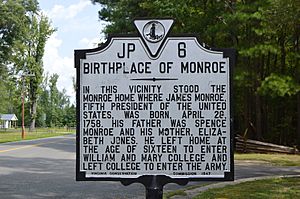
His paternal great-great-grandfather Patrick Andrew Monroe emigrated to America from Scotland in the mid-17th century, and was part of an ancient Scottish clan known as Clan Munro. In 1650 he patented a large tract of land in Washington Parish, Westmoreland County, Virginia. Monroe's mother was the daughter of James Jones, who immigrated from Wales and settled in nearby King George County, Virginia. Jones was a wealthy architect. Also among James Monroe's ancestors were French Huguenot immigrants, who came to Virginia in 1700.
At age 11, Monroe was enrolled in Campbelltown Academy, the lone school in the county. He attended this school only 11 weeks a year, as his labor was needed on the farm. During this time, Monroe formed a lifelong friendship with an older classmate, John Marshall. Monroe's mother died in 1772, and his father two years later. Though he inherited property, including slaves, from both of his parents, the 16-year-old Monroe was forced to withdraw from school to support his younger brothers. His childless maternal uncle, Joseph Jones, became a surrogate father to Monroe and his siblings. A member of the Virginia House of Burgesses, Jones took Monroe to the capital of Williamsburg, Virginia, and enrolled him in the College of William and Mary. Jones also introduced Monroe to important Virginians such as Thomas Jefferson, Patrick Henry, and George Washington. In 1774, opposition to the British government grew in the Thirteen Colonies in reaction to the "Intolerable Acts", and Virginia sent a delegation to the First Continental Congress. Monroe became involved in the opposition to Lord Dunmore, the colonial governor of Virginia, and took part in the storming of the Governor's Palace.
Revolutionary War service
In early 1776, about a year and a half after his enrollment, Monroe dropped out of college and joined the 3rd Virginia Regiment in the Continental Army. In late December, Monroe took part in a surprise attack on a Hessian encampment at the Battle of Trenton. Though the attack was successful, Monroe suffered a severed artery in the battle and nearly died. In the aftermath, Washington cited Monroe and William Washington for their bravery, and promoted Monroe to captain. After his wounds healed, Monroe returned to Virginia to recruit his own company of soldiers. His participation in the battle was memorialized in John Trumbull's painting The Capture of the Hessians at Trenton, December 26, 1776 as well as Emanuel Leutze's 1851 Washington Crossing the Delaware.
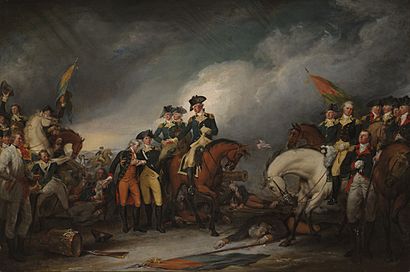
With letters of recommendation from Washington, Stirling, and Alexander Hamilton, Monroe received a commission as a lieutenant colonel and was expected to lead one of the regiments, but recruitment proved to be a problem. Monroe returned to Williamsburg to study law, becoming a protege of Virginia Governor Thomas Jefferson.
With the British increasingly focusing their operations in the Southern colonies, the Virginians moved the capital to the more defensible city of Richmond, and Monroe accompanied Jefferson to the new capital. As governor of Virginia, Jefferson held command over its militia, and made Monroe a colonel. Monroe established a messenger network to coordinate with the Continental Army and other state militias. Still unable to raise an army due to a lack of interested recruits, Monroe traveled to his home in King George County, and thus was not present for the British raid of Richmond. As both the Continental Army and the Virginia militia had an abundance of officers, Monroe did not serve during the Yorktown campaign, and, much to his frustration, did not take part in the Siege of Yorktown. Although Andrew Jackson served as a courier in a militia unit at age 13, Monroe is regarded as the last U.S. president who was a Revolutionary War veteran, since he served as an officer of the Continental Army and took part in combat. As a result of his service, Monroe became a member of the Society of the Cincinnati.
Monroe resumed studying law under Jefferson and continued until 1783. He was not particularly interested in legal theory or practice, but chose to take it up because he thought it offered "the most immediate rewards" and could ease his path to wealth, social standing, and political influence. Monroe was admitted to the Virginia bar and practiced in Fredericksburg, Virginia.
Political career
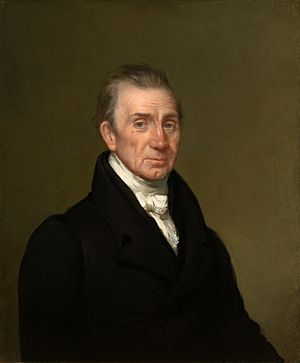
Monroe was elected to the Virginia House of Delegates in 1782. After serving on Virginia's Executive Council, he was elected to the Congress of the Confederation in November 1783 and served in Annapolis until Congress convened in Trenton, New Jersey in June 1784. He had served a total of three years when he finally retired from that office by the rule of rotation. By that time, the government was meeting in the temporary capital of New York City. In 1784, Monroe undertook an extensive trip through Western New York and Pennsylvania to inspect the conditions in the Northwest. The tour convinced him that the United States had to pressure Britain to abandon its posts in the region and assert control of the Northwest. While serving in Congress, Monroe became an advocate for western expansion, and played a key role in the writing and passage of the Northwest Ordinance. The ordinance created the Northwest Territory, providing for federal administration of the territories West of Pennsylvania and North of the Ohio River. During this period, Jefferson continued to serve as a mentor to Monroe, and, at Jefferson's prompting, he befriended another prominent Virginian, James Madison.
Monroe resigned from Congress in 1786 to focus on his legal career. In 1788, Monroe became a delegate to the Virginia Ratifying Convention. He opposed the ratification of the United States Constitution.
In 1790, he won election to the Senate where he became a leader of the Democratic-Republican Party. He left the Senate in 1794 to serve as President George Washington's ambassador to France. There he experienced several early diplomatic successes, including the protection of U.S. trade from French attacks. Months after Monroe arrived in France, the U.S. and Great Britain concluded the Jay Treaty, outraging both the French and Monroe—not fully informed about the treaty prior to its publication. Despite the undesirable effects of the Jay Treaty on Franco-American relations, Monroe won French support for U.S. navigational rights on the Mississippi River—the mouth of which was controlled by Spain—and in 1795 the U.S. and Spain signed Pinckney's Treaty. The treaty granted the U.S. limited rights to use the port of New Orleans. Washington decided to recall Monroe in November 1796.
Monroe won the election as Governor of Virginia in 1799 and strongly supported Jefferson's candidacy in the 1800 presidential election.
As President Jefferson's special envoy, Monroe helped negotiate the Louisiana Purchase, through which the United States nearly doubled in size. Monroe fell out with his longtime friend James Madison after Madison rejected the Monroe–Pinkney Treaty that Monroe negotiated with Britain. He unsuccessfully challenged Madison for the Democratic-Republican nomination in the 1808 presidential election, but he joined Madison's administration as Secretary of State in 1811. During the later stages of the War of 1812, Monroe simultaneously served as Madison's Secretary of State and Secretary of War. Monroe's wartime leadership established him as Madison's heir apparent, and he easily defeated Federalist candidate Rufus King in the 1816 presidential election.
Presidency (1817–1825)
As president, Monroe signed the Missouri Compromise, which admitted Missouri as a slave state and banned slavery from territories north of the 36°30′ parallel. Though Monroe remained firmly opposed to any compromise that restricted slavery anywhere, he reluctantly signed the Compromise into law (March 6, 1820) only because he believed it was the least bad alternative for southern slaveholders.
Two years into his presidency, Monroe faced an economic crisis known as the Panic of 1819, the first major depression to hit the country since the ratification of the Constitution in 1788. The panic stemmed from declining imports and exports, and sagging agricultural prices as global markets readjusted to peacetime production and commerce in the aftermath of the War of 1812 and the Napoleonic Wars. The severity of the economic downturn in the U.S. was compounded by excessive speculation in public lands, fueled by the unrestrained issue of paper money from banks and business concerns. Monroe lacked the power to intervene directly in the economy, as banks were largely regulated by the states, and he could do little to stem the economic crisis.
Before the onset of the Panic of 1819, some business leaders had called on Congress to increase tariff rates to address the negative balance of trade and help struggling industries. As the panic spread, Monroe declined to call a special session of Congress to address the economy. When Congress finally reconvened in December 1819, Monroe requested an increase in the tariff but declined to recommend specific rates. Congress would not raise tariff rates until the passage of the Tariff of 1824. The panic resulted in high unemployment and an increase in bankruptcies and foreclosures, and provoked popular resentment against banking and business enterprises.
In foreign affairs, Monroe and Secretary of State John Quincy Adams favored a policy of conciliation with Britain and a policy of expansionism against the Spanish Empire. In 1817, the United States and Britain signed the Rush–Bagot Treaty, which regulated naval armaments on the Great Lakes and Lake Champlain and demilitarized the border between the U.S. and British North America. The Treaty of 1818, also with Great Britain, was concluded October 20, 1818, and fixed the present Canada–United States border from Minnesota to the Rocky Mountains at the 49th parallel. The accords also established a joint U.S.–British occupation of Oregon Country for the next ten years. Though they did not solve every outstanding issue between the U.S. and Britain, the treaties allowed for greater trade between the United States and the British Empire and helped avoid an expensive naval arms race in the Great Lakes. Late in Monroe's second term, the U.S. concluded the Russo-American Treaty of 1824 with the Russian Empire, setting the southern limit of Russian sovereignty on the Pacific coast of North America at the 54°40′ parallel (the present southern tip of the Alaska Panhandle).
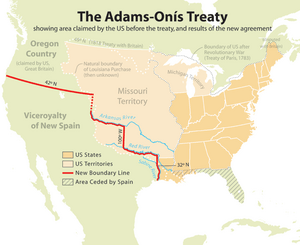
In the 1819 Adams–Onís Treaty with Spain, the United States secured Florida and established its western border with New Spain.
Monroe was deeply sympathetic to the Latin American revolutionary movements against Spain. He was determined that the United States should never repeat the policies of the Washington administration during the French Revolution, when the nation had failed to demonstrate its sympathy for the aspirations of peoples seeking to establish republican governments. He did not envisage military involvement in Latin American affairs, but only the provision of moral support, as he believed that a direct American intervention would provoke other European powers into assisting Spain. Monroe initially refused to recognize the Latin American governments due to ongoing negotiations with Spain over Florida.
In March 1822, Monroe officially recognized the countries of Argentina, Peru, Colombia, Chile, and Mexico, all of which had won independence from Spain. Secretary of State Adams, under Monroe's supervision, wrote the instructions for the ministers to these new countries. They declared that the policy of the United States was to uphold republican institutions and to seek treaties of commerce on a most-favored-nation basis.
In 1823, Monroe announced the United States' opposition to any European intervention in the recently independent countries of the Americas with the Monroe Doctrine, which became a landmark in American foreign policy. Monroe was a member of the American Colonization Society which supported the colonization of Africa by freed slaves, and Liberia's capital of Monrovia is named in his honor.
States admitted to the Union
Five new states were admitted to the Union while Monroe was in office:
- Mississippi – December 10, 1817
- Illinois – December 3, 1818
- Alabama – December 14, 1819
- Maine – March 15, 1820
- Missouri – August 10, 1821
Post-presidency (1825–1831)
When his presidency ended on March 4, 1825, James Monroe resided at Monroe Hill, what is now included in the grounds of the University of Virginia. He served on the university's Board of Visitors under Jefferson and under the second rector James Madison, both former presidents, almost until his death. He and his wife lived at Oak Hill in Aldie, Virginia, until Elizabeth's death at age 62 on September 23, 1830.
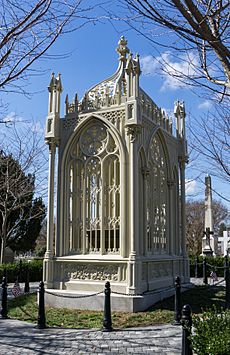
Upon Elizabeth's death in 1830, Monroe moved to 63 Prince Street at Lafayette Place in New York City to live with his daughter Maria Hester Monroe Gouverneur, who had married Samuel L. Gouverneur. Monroe's health began to slowly fail by the end of the 1820s. On July 4, 1831, Monroe died at age 73 from heart failure and tuberculosis, thus becoming the third president to have died on Independence Day. His death came 55 years after the United States Declaration of Independence was proclaimed and five years after the deaths of John Adams and Thomas Jefferson. Monroe was originally buried in New York at the Gouverneur family's vault in the New York City Marble Cemetery. 27 years later, in 1858, his body was re-interred at the President's Circle in Hollywood Cemetery in Richmond, Virginia. The James Monroe Tomb is a U.S. National Historic Landmark.
Marriage and family
On February 16, 1786, Monroe married Elizabeth Kortright (1768–1830) in New York City. She was the daughter of Hannah Aspinwall Kortright and Laurence Kortright, a wealthy trader and former British officer. Monroe met her while serving in the Continental Congress.
After a brief honeymoon on Long Island, New York, the Monroes returned to New York City to live with her father until Congress adjourned. They then moved to Virginia, settling in Charlottesville, Virginia, in 1789. They bought an estate in Charlottesville known as Ash Lawn–Highland, settling on the property in 1799. The Monroes had three children.
- Eliza Monroe Hay was born in Fredericksburg, Virginia, in 1786, and was educated in Paris at the school of Madame Campan during the time her father was the United States Ambassador to France. In 1808 she married George Hay, a prominent Virginia attorney who had served as prosecutor in the trial of Aaron Burr and later as a U.S. District Judge. She died in 1840.
- James Spence Monroe was born in 1799 and died sixteen months later in 1800.
- Maria Hester Monroe (1802–1850) married her cousin Samuel L. Gouverneur on March 8, 1820, in the White House, the first president's child to marry there.
Plantations and slavery
Monroe sold his small Virginia plantation in 1783 to enter law and politics. Although he owned multiple properties over the course of his lifetime, his plantations were never profitable. Although he owned much more land and many more slaves, and speculated in property, he was rarely on site to oversee the operations. Overseers treated the slaves harshly to force production, but the plantations barely broke even. Monroe incurred debts by his lavish and expensive lifestyle and often sold property (including slaves) to pay them off. The labor of Monroe's many slaves were also used to support his daughter and son-in-law, along with a ne'er-do-well brother, Andrew, and his son, James.
During the course of his presidency, Monroe remained convinced that slavery was wrong and supported private manumission, but at the same time he insisted that any attempt to promote emancipation would cause more problems. Monroe believed that slavery had become a permanent part of southern life, and that it could only be removed on providential terms. Like so many other Upper South slaveholders, Monroe believed that a central purpose of government was to ensure "domestic tranquility" for all. Yet he also believed that the central purpose of government was to empower planters like himself.
Legacy
Historical reputation
Polls of historians and political scientists tend to rank Monroe as an above average president. Monroe presided over a period in which the United States began to turn away from European affairs and towards domestic issues. His presidency saw the United States settle many of its longstanding boundary issues through an accommodation with Britain and the acquisition of Florida. Monroe also helped resolve sectional tensions through his support of the Missouri Compromise and by seeking support from all regions of the country. Political scientist Fred Greenstein argues that Monroe was a more effective executive than some of his better-known predecessors, including Madison and John Adams.
Memorials
The capital of Liberia is named Monrovia after Monroe; it is the only national capital other than Washington, D.C., named after a U.S. president. Monroe is the namesake of seventeen Monroe counties. Monroe, Maine, Monroe, Michigan, Monroe, Georgia, Monroe, Connecticut, both Monroe Townships in New Jersey, and Fort Monroe are all named for him. Monroe has been depicted on U.S. currency and stamps, including a 1954 United States Postal Service 5¢ Liberty Issue postage stamp.
Monroe was the last U.S. president to wear a powdered wig tied in a queue, a tricorne hat and knee-breeches according to the style of the late 18th century. That earned him the nickname "The Last Cocked Hat". He was also the last president who was not photographed.
See also
 In Spanish: James Monroe para niños
In Spanish: James Monroe para niños


